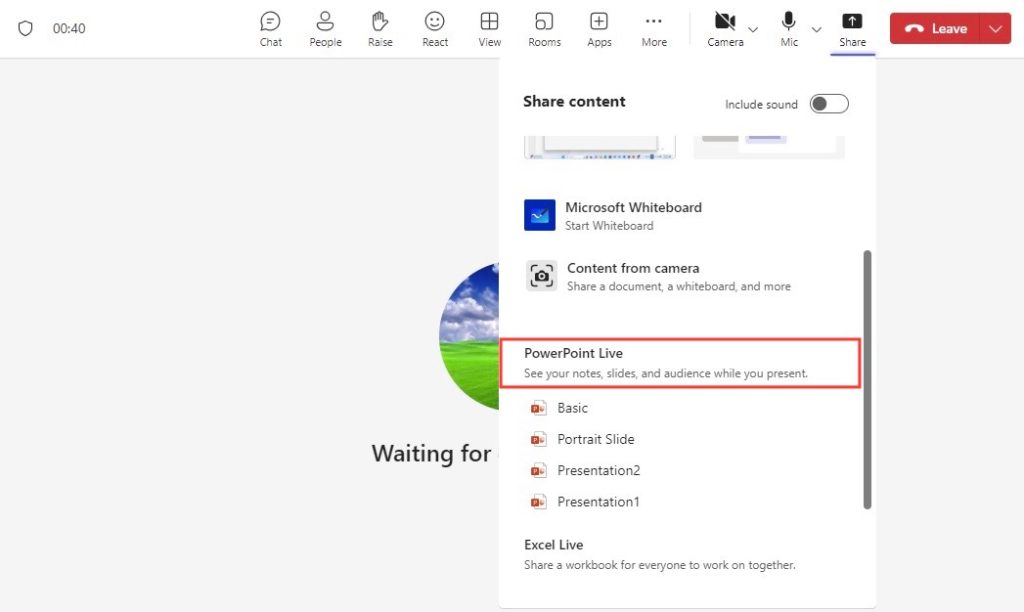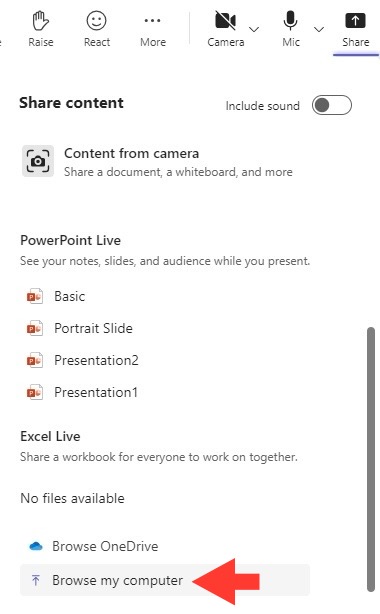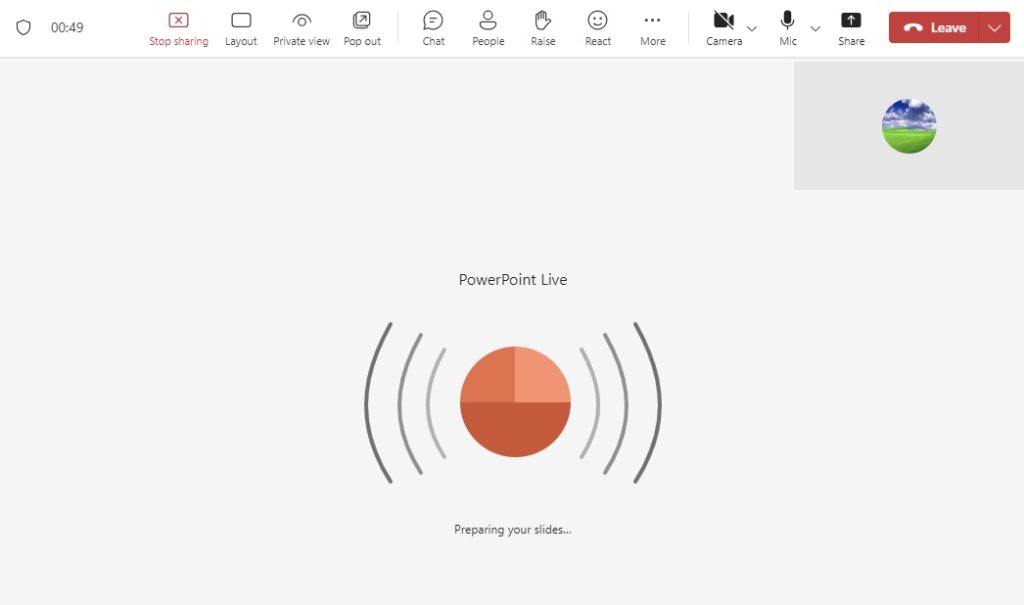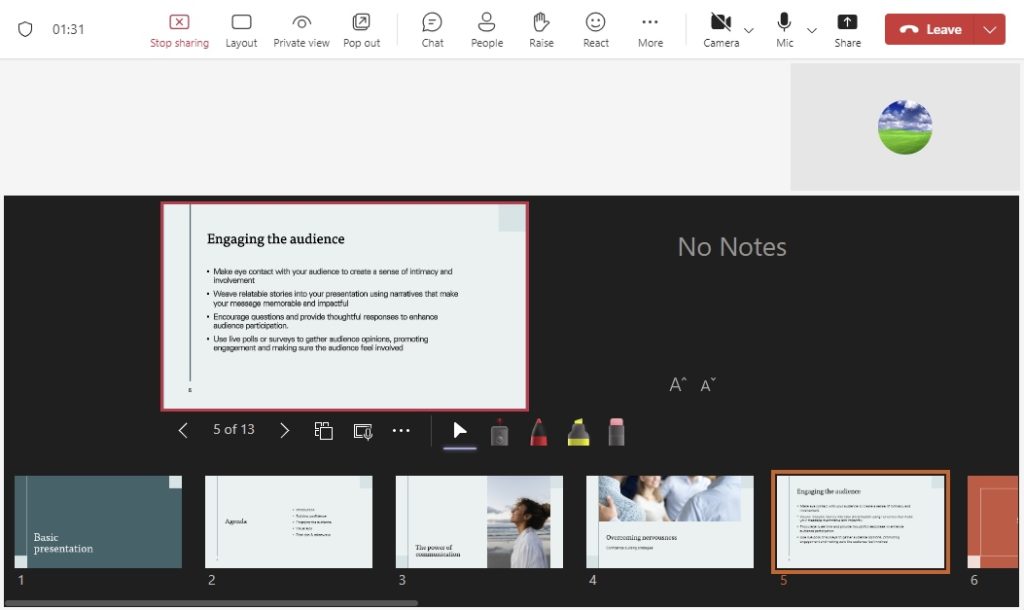Presentations are a key part of collaboration in the business world, and they have the ability to transform your team meetings from routine to remarkable. With the right tools, like PowerPoint, you can effectively communicate ideas, strategize as a team, and track progress toward your goals. Think of a presentation as a visual handshake—a way to engage your colleagues, promote teamwork, and drive home key points with impact.
Learn about Excel with our Free Microsoft Excel Online Course!
Key Takeaways
- Utilize the “Share > PowerPoint Live” feature in Teams to present your PowerPoint easily, allowing for options to include computer sound for audio-rich slides and offering quick access to your presentations or the ability to browse for files on OneDrive or your computer.
- Navigate your presentation with ease by using simple controls such as keyboard arrows, page navigation, and slide selection to advance or return to slides, and manage the view for participants by locking slides, using Presenter mode, and customizing your own view with more actions like notes and high-contrast mode.
- Engage both as a presenter and an audience member by mixing content visibility with chat interaction, reviewing slides in grid format, and enriching the viewing experience with features like live links and adjustable settings like high-contrast mode.
Embracing PowerPoint for Enhanced Team Meetings
PowerPoint is a powerhouse when it comes to visual communication, and it’s a fantastic asset for team meetings. By embracing PowerPoint, you enable your team to see the bigger picture through data visualizations, compelling narratives, and engaging graphics. When ideas are presented visually, they’re easier to understand and remember, making PowerPoint presentations in Teams meetings effective. Imagine bridging the gap between concepts and executions with slides that do more than just tell—they show.
Table of Contents
Setting the Stage
What Makes PowerPoint a Go-To for Team Meetings?
PowerPoint’s widespread adoption in the corporate environment lies in its versatility and familiarity. It’s a go-to for team meetings because it provides a structured way to present complex ideas, fosters a creative environment for brainstorming, and facilitates an easy-to-follow flow of information. With an array of templates and design tools, PowerPoint allows presenters to create professional-looking slides that can be customized to match the company branding and presentation goals. Additionally, its easy integration with other Microsoft Office tools, and particularly its seamless functionality within Teams, makes it an indispensable tool for team collaboration.
The Benefits of Integrating PowerPoint into Teams
Taking advantage of PowerPoint within Microsoft Teams elevates not just the presentations themselves, but the entire meeting experience. First, it fosters inclusivity by allowing team members to follow along and participate, regardless of their location. Real-time collaboration becomes a breeze—edits and suggestions can be made on the spot. PowerPoint Live in Teams enhances engagement by allowing audience members to interact with the content, like asking questions directly on slides. Moreover, since it’s linked to the broader Office 365 environment, you get the benefit of centralized, secure access to presentations across your organization. This integration reduces delays in sharing screens or documents, streamlines meetings, and ultimately saves everyone’s valuable time.
Step-by-Step Guide to Sharing Presentations
Preparing Your PowerPoint Slides for Seamless Sharing
When preparing your PowerPoint slides for sharing in Teams, focus on legibility and simplification. Ensure text is large enough to read on various screen sizes, and limit the amount of text to avoid clutter—bullets points are your ally. Opt for high-contrast color schemes to guarantee visibility. If your presentation includes audio or video, double-check file compatibility and functionality within Teams. Visual consistency across slides aids in maintaining audience engagement, so consider using a template aligned with your organization’s branding. Don’t forget to review your slides to ensure that they are free of errors and that animations and transitions work smoothly, to ensure seamless sharing when it’s showtime.
Navigating Microsoft Teams to Share Your Presentation
To share your PowerPoint presentation during a Microsoft Teams meeting, start by joining the meeting as usual.
STEP 1: Once in, find and select the ‘Share’ option.
STEP 2: Then choose ‘PowerPoint Live’ and pick your presentation from the provided list. If there’s audio in your slides, remember to check the ‘Include computer sound’ box. Should your file not appear, you can browse your OneDrive or computer to upload it directly. After you’ve shared the presentation, it’ll take a brief moment to load on everyone’s devices—don’t worry, this typically takes just 5 to 10 seconds.
To navigate through your slides, you can use straightforward actions such as the arrow keys or space bar, enabling a smooth and professional experience for you and your audience. Plus, Teams offers various view controls and annotation tools to make sure your presentation is not just shared, but effectively communicated.
Best Practices for Presentation Sharing
Engaging Your Audience with Interactive Elements
Interactive elements are crucial for keeping your audience engaged during virtual presentations. With PowerPoint in Teams, you can incorporate quizzes, polls, and Q&A sessions to maintain active participation. Real-time feedback is possible through Teams’ built-in features like live reactions, allowing the audience to respond instantly to what they see and hear. You can also use in-slide hyperlinks to introduce supplementary resources, and live video feeds to humanize and add a personal touch to your presentation.
Remember, the goal is to create an immersive experience where your team members feel involved and motivated to contribute. By integrating these interactive elements, you turn passive listeners into active participants, retaining attention and fostering a collaborative atmosphere throughout your presentation.
Utilizing Teams Features to Boost Participation
To boost participation within Microsoft Teams, don’t just share your slides—make the session lively and interactive. Use the ‘Hand raise’ feature to manage audience questions without interrupting the flow. Encourage the use of the chat function for real-time discussions and insights. Enable live captions to assist team members who may be hard of hearing or who speak different languages. PowerPoint Live’s feature to allow audience members to navigate the presentation independently also empowers them to engage with the content at their own pace.
These features not only make your presentation more accessible but also promote a culture of inclusivity and active engagement. By leveraging these tools, you’re likely to see a more dynamic, interactive, and productive team meeting.
Troubleshooting Common Issues
Overcoming Technical Glitches when presenting in Teams
Troubleshooting technical issues is part and parcel of any virtual presentation. To overcome glitches while presenting in Teams, ensure a stable internet connection beforehand to minimize disruptions. If you encounter audio or video problems, first verify that your equipment is properly connected and functioning. It’s helpful to have a quick guide at your fingertips for resolving common technical issues, like switching audio inputs or adjusting share settings.
In case the presentation fails to load or lags, be ready with a backup plan—keep a PDF version of your slides handy to share via screen sharing as an alternative. Patience and a calm approach are essential; a little humor can also go a long way in keeping the audience engaged while you handle the hiccup.
Tips for Smooth Transitioning Among Slides and Presenters
To ensure smooth transitions between slides and presenters, coordination and practice are key. Use clear and consistent transition slides or phrases that signal a change in speakers or topics. Establish beforehand the order of presenters and rehearse the hand-off to make sure everyone is familiar with the process. Consider using the ‘Give Control’ feature in Teams to seamlessly pass the presenter role to the next speaker.
Also, set up your slides to advance automatically at predetermined intervals to maintain a steady pace, or use remote clickers for manual control. With a bit of planning and these tips, your team’s presentation will flow effortlessly, maintaining a professional and cohesive narrative throughout the meeting.
Advanced Techniques and Tools
Leveraging PowerPoint’s Advanced Features for Team Meetings
PowerPoint is brimming with advanced features to enhance your team meetings. Dive into ‘Morph Transition’ to create smooth, cinematic motion between slides. Harness the power of ‘Zoom’ to build a dynamic, non-linear presentation. Slide ‘Sections’ help you organize ideas, and ‘Presenter View’ gives you access to your notes, a timer, and a preview of upcoming slides—ensuring you’re fully prepared before the audience sees anything.
Additionally, you can incorporate ‘3D Models’ and ‘Animations’ to make complex data more digestible and engaging. By tapping into these advanced features, your presentations can evolve from a series of slides into a compelling story that captivates your team’s attention and drives your points home.
Add-ons and Plugins That Enhance Presentation Sharing in Teams
Extend the capabilities of your PowerPoint presentations in Teams with an array of add-ons and plugins designed for collaboration and interactivity. Consider using plugins like Poll Everywhere or Slido to facilitate real-time polling and audience feedback. Microsoft’s own Forms can be integrated directly into slides for quick surveys. For more robust data visualization, the Power BI plugin can turn your slides into interactive dashboards.
These tools not only enrich the presentation experience but also foster a dialogue between presenter and audience, making meetings more dynamic, informative, and engaging. When selecting add-ons and plugins, ensure they align with your team’s needs and that everyone is familiar with how to use them for a seamless experience.
Frequently Asked Questions (FAQ)
How do you effectively share a PowerPoint presentation in a team meeting?
To effectively share a PowerPoint presentation in a team, initiate by joining the Teams meeting, then select ‘Share’ followed by PowerPoint Live. Choose your file from the list or upload it. If there’s audio content in your slides, ensure to activate ‘Include computer sound’. Use navigation tools to move through your presentation and keep your audience on the same slide by using the slide lock feature. Remember to engage with your audience using the interactive functionalities Teams provides for a compelling presentation experience.
How to present in Teams but still see participants?
To present in Teams while continually seeing participants, select ‘People’ from the presenter toolbar to keep the main Teams window with the participant pane open. Turn on your camera and choose a layout like ‘Standout’, ‘Side-by-side’, or ‘Reporter’ to remain visible alongside your content. With PowerPoint Live, control your presentation and still stay connected with participants through their video feeds, raised hands, reactions, and chat by toggling between your presentation and the Teams audience view as needed.
Can multiple team members collaborate on a PowerPoint while presenting in Teams?
Yes, multiple team members can collaborate on a PowerPoint presentation in real-time while presenting in Teams. Use PowerPoint Live to allow team members to advance slides independently or take control with the presenter’s permission. Collaborators can also make live edits to slides, which are updated instantly for all participants to see. Ensure that the PowerPoint file is shared with your team and stored in a common area like SharePoint or OneDrive for seamless access and collaboration during the presentation.
John Michaloudis is a former accountant and finance analyst at General Electric, a Microsoft MVP since 2020, an Amazon #1 bestselling author of 4 Microsoft Excel books and teacher of Microsoft Excel & Office over at his flagship MyExcelOnline Academy Online Course.












